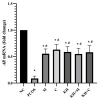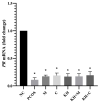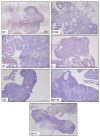Kelulut Honey Regulates Sex Steroid Receptors in a Polycystic Ovary Syndrome Rat Model
- PMID: 36499085
- PMCID: PMC9738483
- DOI: 10.3390/ijms232314757
Kelulut Honey Regulates Sex Steroid Receptors in a Polycystic Ovary Syndrome Rat Model
Abstract
Reproductive and metabolic anomalies in polycystic ovary syndrome (PCOS) have been associated with the dysregulation of sex steroid receptors. Kelulut honey (KH) has been shown to be beneficial in PCOS-induced rats by regulating folliculogenesis and the oestrus cycle. However, no study has been conducted to evaluate KH's effect on sex steroid receptors in PCOS. Therefore, the current study examined the effects of KH, metformin, or clomiphene alone and in combination on the mRNA expression and protein distribution of androgen receptor (AR), oestrogen receptor α (ERα), oestrogen receptor β (ERβ), and progesterone receptor (PR) in PCOS-induced rats. The study used female Sprague-Dawley rats, which were treated orally with 1 mg/kg/day of letrozole for 21 days to develop PCOS. PCOS-induced rats were then divided and treated orally for 35 days with KH, metformin, clomiphene, KH + metformin, KH+ clomiphene and distilled water. In this study, we observed aberrant AR, ERα, ERβ and PR expression in PCOS-induced rats compared with the normal control rats. The effects of KH treatment were comparable with clomiphene and metformin in normalizing the expression of AR, ERα, and ERβ mRNA. However, KH, clomiphene and metformin did not affect PR mRNA expression and protein distribution. Hence, this study confirms the aberrant expression of sex steroid receptors in PCOS and demonstrates that KH treatment could normalise the sex steroid receptors profile. The findings provide a basis for future clinical trials to utilize KH as a regulator of sex steroid receptors in patients with PCOS.
Keywords: PCOS; androgen receptor; honey; oestrogen receptors; progesterone receptor.
Conflict of interest statement
The authors declare no conflict of interest.
Figures








Similar articles
-
Kelulut Honey Improves Folliculogenesis, Steroidogenic, and Aromatase Enzyme Profiles and Ovarian Histomorphology in Letrozole-Induced Polycystic Ovary Syndrome Rats.Nutrients. 2022 Oct 18;14(20):4364. doi: 10.3390/nu14204364. Nutrients. 2022. PMID: 36297046 Free PMC article.
-
Kelulut Honey Ameliorates Oestrus Cycle, Hormonal Profiles, and Oxidative Stress in Letrozole-Induced Polycystic Ovary Syndrome Rats.Antioxidants (Basel). 2022 Sep 22;11(10):1879. doi: 10.3390/antiox11101879. Antioxidants (Basel). 2022. PMID: 36290602 Free PMC article.
-
Effects of Kelulut Honey on Oestrus Cycle Regulation and Histomorphological Changes in Letrozole-Induced Polycystic Ovary Syndrome Rats: A Preliminary Study.Life (Basel). 2022 Jun 14;12(6):890. doi: 10.3390/life12060890. Life (Basel). 2022. PMID: 35743921 Free PMC article.
-
Sex Steroid Receptors in Polycystic Ovary Syndrome and Endometriosis: Insights from Laboratory Studies to Clinical Trials.Biomedicines. 2022 Jul 14;10(7):1705. doi: 10.3390/biomedicines10071705. Biomedicines. 2022. PMID: 35885010 Free PMC article. Review.
-
The utility of metformin therapy in reproductive-aged women with polycystic ovary syndrome (PCOS).Curr Pharm Biotechnol. 2014;15(1):70-83. doi: 10.2174/1389201015666140330195142. Curr Pharm Biotechnol. 2014. PMID: 24720592 Review.
Cited by
-
Administration of adipose-derived mesenchymal stem cell conditioned medium improves ovarian function in polycystic ovary syndrome rats: involvement of epigenetic modifiers system.J Ovarian Res. 2023 Dec 15;16(1):238. doi: 10.1186/s13048-023-01317-9. J Ovarian Res. 2023. PMID: 38102694 Free PMC article.
-
The Utilization of Bee Products as a Holistic Approach to Managing Polycystic Ovarian Syndrome-Related Infertility.Nutrients. 2023 Feb 25;15(5):1165. doi: 10.3390/nu15051165. Nutrients. 2023. PMID: 36904163 Free PMC article. Review.
References
-
- Gupta M., Singh D., Toppo M., Priya A., Sethia S., Gupta P. A cross sectional study of polycystic ovarian syndrome among young women in Bhopal, Central India. Int. J. Community Med. Public Health. 2018;5:95–100. doi: 10.18203/2394-6040.ijcmph20175603. - DOI
MeSH terms
Substances
Grants and funding
LinkOut - more resources
Full Text Sources
Medical
Research Materials

